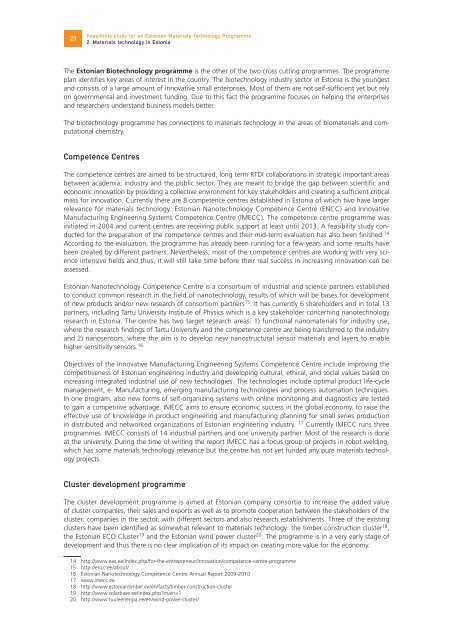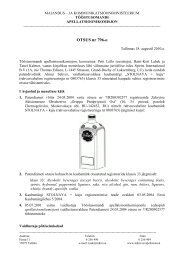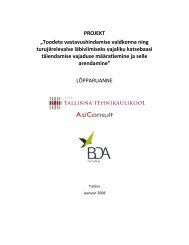Feasibility study for an Estonian Materials Technology Programme
Feasibility study for an Estonian Materials Technology Programme
Feasibility study for an Estonian Materials Technology Programme
You also want an ePaper? Increase the reach of your titles
YUMPU automatically turns print PDFs into web optimized ePapers that Google loves.
23<br />
<strong>Feasibility</strong> <strong>study</strong> <strong>for</strong> <strong>an</strong> Estoni<strong>an</strong> <strong>Materials</strong> <strong>Technology</strong> <strong>Programme</strong><br />
2. <strong>Materials</strong> technology in Estonia<br />
The Estoni<strong>an</strong> Biotechnology programme is the other of the two cross cutting programmes. The programme<br />
pl<strong>an</strong> identifies key areas of interest in the country. The biotechnology industry sector in Estonia is the youngest<br />
<strong>an</strong>d consists of a large amount of innovative small enterprises. Most of them are not self-sufficient yet but rely<br />
on governmental <strong>an</strong>d investment funding. Due to this fact the programme focuses on helping the enterprises<br />
<strong>an</strong>d researchers underst<strong>an</strong>d business models better.<br />
The biotechnology programme has connections to materials technology in the areas of biomaterials <strong>an</strong>d computational<br />
chemistry.<br />
Competence Centres<br />
The competence centres are aimed to be structured, long term RTDI collaborations in strategic import<strong>an</strong>t areas<br />
between academia, industry <strong>an</strong>d the public sector. They are me<strong>an</strong>t to bridge the gap between scientific <strong>an</strong>d<br />
economic innovation by providing a collective environment <strong>for</strong> key stakeholders <strong>an</strong>d creating a sufficient critical<br />
mass <strong>for</strong> innovation. Currently there are 8 competence centres established in Estonia of which two have larger<br />
relev<strong>an</strong>ce <strong>for</strong> materials technology: Estoni<strong>an</strong> N<strong>an</strong>otechnology Competence Centre (ENCC) <strong>an</strong>d Innovative<br />
M<strong>an</strong>ufacturing Engineering Systems Competence Centre (IMECC). The competence centre programme was<br />
initiated in 2004 <strong>an</strong>d current centres are receiving public support at least until 2013. A feasibility <strong>study</strong> conducted<br />
<strong>for</strong> the preparation of the competence centres <strong>an</strong>d their mid-term evaluation has also been finished. 14<br />
According to the evaluation, the programme has already been running <strong>for</strong> a few years <strong>an</strong>d some results have<br />
been created by different partners. Nevertheless, most of the competence centres are working with very science<br />
intensive fields <strong>an</strong>d thus, it will still take time be<strong>for</strong>e their real success in increasing innovation c<strong>an</strong> be<br />
assessed.<br />
Estoni<strong>an</strong> N<strong>an</strong>otechnology Competence Centre is a consortium of industrial <strong>an</strong>d science partners established<br />
to conduct common research in the field of n<strong>an</strong>otechnology, results of which will be bases <strong>for</strong> development<br />
of new products <strong>an</strong>d/or new research of consortium partners 15 . It has currently 6 shareholders <strong>an</strong>d in total 13<br />
partners, including Tartu University Institute of Physics which is a key stakeholder concerning n<strong>an</strong>otechnology<br />
research in Estonia. The centre has two target research areas: 1) functional n<strong>an</strong>omaterials <strong>for</strong> industry use,<br />
where the research findings of Tartu University <strong>an</strong>d the competence centre are being tr<strong>an</strong>sferred to the industry<br />
<strong>an</strong>d 2) n<strong>an</strong>osensors, where the aim is to develop new n<strong>an</strong>ostructural sensor materials <strong>an</strong>d layers to enable<br />
higher sensitivity sensors. 16<br />
Objectives of the Innovative M<strong>an</strong>ufacturing Engineering Systems Competence Centre include improving the<br />
competitiveness of Estoni<strong>an</strong> engineering industry <strong>an</strong>d developing cultural, ethical, <strong>an</strong>d social values based on<br />
increasing integrated industrial use of new technologies. The technologies include optimal product life-cycle<br />
m<strong>an</strong>agement, e- M<strong>an</strong>ufacturing, emerging m<strong>an</strong>ufacturing technologies <strong>an</strong>d process automation techniques.<br />
In one program, also new <strong>for</strong>ms of self-org<strong>an</strong>izing systems with online monitoring <strong>an</strong>d diagnostics are tested<br />
to gain a competitive adv<strong>an</strong>tage. IMECC aims to ensure economic success in the global economy, to raise the<br />
effective use of knowledge in product engineering <strong>an</strong>d m<strong>an</strong>ufacturing pl<strong>an</strong>ning <strong>for</strong> small series production<br />
in distributed <strong>an</strong>d networked org<strong>an</strong>izations of Estoni<strong>an</strong> engineering industry. 17 Currently IMECC runs three<br />
programmes. IMECC consists of 14 industrial partners <strong>an</strong>d one university partner. Most of the research is done<br />
at the university. During the time of writing the report IMECC has a focus group of projects in robot welding,<br />
which has some materials technology relev<strong>an</strong>ce but the centre has not yet funded <strong>an</strong>y pure materials technology<br />
projects.<br />
Cluster development programme<br />
The cluster development programme is aimed at Estoni<strong>an</strong> comp<strong>an</strong>y consortia to increase the added value<br />
of cluster comp<strong>an</strong>ies, their sales <strong>an</strong>d exports as well as to promote cooperation between the stakeholders of the<br />
cluster: comp<strong>an</strong>ies in the sector, with different sectors <strong>an</strong>d also research establishments. Three of the existing<br />
clusters have been identified as somewhat relev<strong>an</strong>t to materials technology: the timber construction cluster 18 ,<br />
the Estoni<strong>an</strong> ECO Cluster 19 <strong>an</strong>d the Estoni<strong>an</strong> wind power cluster 20 . The programme is in a very early stage of<br />
development <strong>an</strong>d thus there is no clear implication of its impact on creating more value <strong>for</strong> the economy.<br />
14 http://www.eas.ee/index.php/<strong>for</strong>-the-entrepreneur/innovation/competence-centre-programme<br />
15 http://encc.ee/about/<br />
16 Estoni<strong>an</strong> N<strong>an</strong>otechnology Competence Centre Annual Report 2009-2010<br />
17 www.imecc.ee<br />
18 http://www.estoni<strong>an</strong>timber.ee/en/facts/timber-construction-cluster<br />
19 http://www.solarbase.ee/index.php?main=1<br />
20 http://www.tuuleenergia.ee/en/wind-power-cluster/





